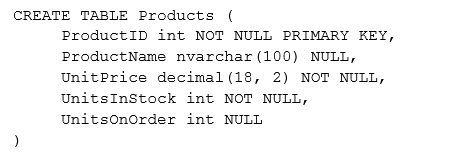

Note: This question is part of a series of questions that present the same scenario. Each question in the series contains a unique solution that might meet the stated goals. Some question sets might have more than one correct solution, while others might not have a correct solution.
After you answer a question in this section. You will NOT be able to return to it. As a result, these questions will not appear in the review screen.
You have a table that was created by running the following Transact-SQL statement:
The Products table includes the data shown in the following table:
TotalUnitPrice is calculated by using the following formula:
TotalUnitPrice = UnitPrice * (UnitsInStock + UnitsOnOrder)
You need to ensure that the value returned for TotalUnitPrice for ProductB is equal to 600.00.
Solution: You run the following Transact-SQL statement:
Does the solution meet the goal?
Vanesa30
5 years, 2 months agoMichael93
4 years, 9 months ago